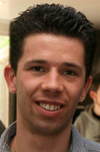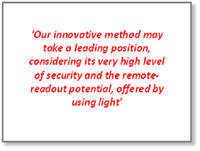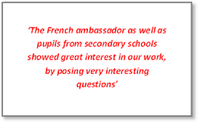 In this thesis the use of shaped wavefronts led to an unprecedented demonstration: quantum-secure authentication of a physical unclonable key. The key is a multiple-scattering medium and cannot be copied. ‘We argue it is the most secure practical authentication method currently available,’ says Bas Goorden.
In this thesis the use of shaped wavefronts led to an unprecedented demonstration: quantum-secure authentication of a physical unclonable key. The key is a multiple-scattering medium and cannot be copied. ‘We argue it is the most secure practical authentication method currently available,’ says Bas Goorden.
‘Work has now started to design a portable demonstrator, to convince main stakeholders in the market to consider choosing this new, potentially disruptive, technology.’
The start of Bas Goorden’s PhD project was a surprising one. His advisors, professors Pepijn Pinkse and Allard Mosk, in collaboration with Boris Škorić of the TU/e, wanted to combine a multiple-scattering medium with quantum optics, for innovative authentication strategies.
‘We combined our ideas with earlier devices, in which the speckle patterns - that are produced when light travels through a multiple-scattering key medium - are verified,’ Bas explains. ‘By using a small number of photons, owing to the quantum nature of light, in our case, the speckle patterns can neither be predicted nor hunted down by an adversary.’
Duplicated

This is an intriguing and new result. Measurements of the incident wave – in order to find the quantum states of the selected photons - will always be blurred, because of the uncertainty principles valid in quantum physics. This means the quantum states used to check the key, can never be duplicated by others.
Bas: ‘We demonstrated this quantum-secure authentication which we called the QSA-method. Also we studied the importance of this finding, and its potential impact on society. Considering its very high level of security combined with the remote-readout potential, offered by using light, QSA may take a leading position. The techniques, functionalities and materials to be used here are straightforward. A user-friendly device is coming within reach.’
Post-doc projects
The idea is patented and in a follow-up project a portable device is worked on in order to convince key stakeholders, within a year. The news was well-received internationally, in the new high-impact journal Optica as well as in popular media.
Most of the work on this device will be done by new forces that joined the team, while Bas will continue for half a year as a post-doc, to work on publications of other aspects of his PhD-work.
Super pixels

He designed and built an apparatus which could be expected to achieve record-high transmission through optically thick media. ‘This apparatus is akin to the QSA procedure,’ Bas says. ‘We also consider it to be an excellent candidate for making first-ever observations of long-lived modes for light in 3D-disordered media, which would be extremely useful in biomedical imaging and may also benefit solar cells, LEDs and security.’
Another topic described in this thesis is a superpixel method for accurate and high-resolution control over light-fields, by grouping 4x4 pixels of a micromirror-based projector. This is a great general tool to control propagation of light in multiple-scattering media at a low cost and very high speed.
Demonstrations
Bas: ‘I was also given the chance to build two demo-devices, used for demonstrating our field of research to the public, for pupils in secondary schools and visitors in conferences. These apparatus show our ability to focus light through opaque media, and compressive ghost imaging. The skills showed here, stem from research performed in Twente or closely related to it. The demo-devices were well-received as well by the French ambassador as by pupils, who showed great interest by posing very interesting questions.’
After his post-doc Bas is attracted to working in industry more than to pursuing a career in academics. ‘The research component at major industry partners such as ASML, Philips and TNO is of a very high level. I like to explore different opportunities for development.
‘My chances here are good, I believe. While working at Mesa+, at the Complex Photonic Physics group, we were always encouraged to broaden our interest in various expertise areas. This I did by visiting the Mesa+ colloquia and by starting collaborations and by discussing frequently about my work, and that of others, with colleagues. This will be favourable in my future job.’
